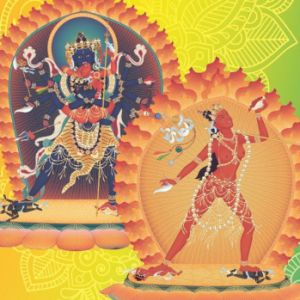What does Vajrayogini mean?
Vajrayogini is Tantric Buddhist deity who represents the path leading to female buddhahood. She is also a dakini (“sky dancer”), a term that describes a female supernatural being or an accomplished yogini, and is considered the queen of the dakinis. She is called Vajravarahi in Tantric Buddhism, or Vajrayana, a tradition in which she is considered the supreme deity — more revered than any male buddha.
Her name is derived from the Sanskrit, vajra, typically translated as “diamond” or “thunderbolt,” and yogini, which is a female yogi, or yoga practitioner.
Vajrayogini is the goddess of grace and destruction, destroying illusion and the ego. She is typically depicted in fierce form, colored blood red. She wears a necklace of skulls and holds a skull cup and flaying knife in her hands. Surrounding her are cremation grounds. Symbolically, the necklace skulls represent the letters of the Sanskrit alphabet and purification of speech. The knife severs worldly attachments, while she pours bliss from the cup to devotees.
Vajrayogini's yoga Tantra practice is believed to be a faster path to enlightenment. Traditionally, both mantras and practices of Vajrayogini are secret, even though many mantras are now widely available on the internet and in books. Traditionalists warn that only a qualified teacher can provide proper guidance for the use of these mantras.
Source
[[1]]
